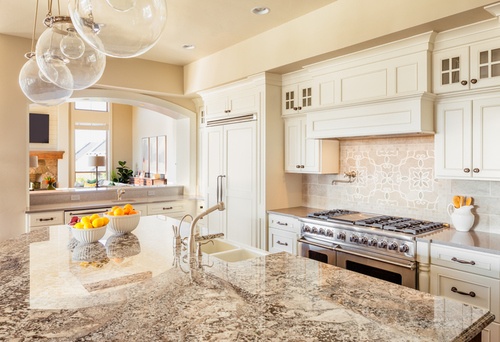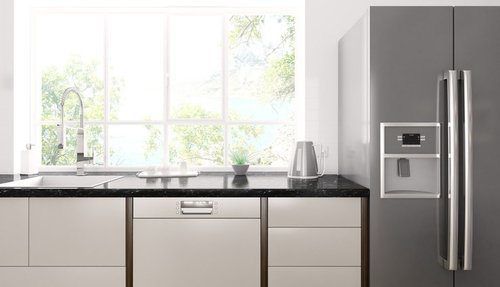Framed vs Frameless Cabinets
Framed Cabinets
$4,740
(for 10x10 kitchen)
VS
Frameless Cabinets
$5,570
(for 10x10 kitchen)
Cost varies greatly by region (and even by zip code).
To get free estimates from local contractors, please indicate yours.
Framed Cabinets

- Less expensive
- Many style options to choose from
- Available in many materials
- Can be hung on uneven walls
- Less accessible and harder to use
- Installation may take longer
- May be made of lighter material
(for 10x10 kitchen)
Get free advice and estimates from kitchen designers in your city.
Frameless Cabinets

- Clean, contemporary style
- Faster installation
- May be made of thicker materials
- More accessible and easier to use
- More expensive
- Available in fewer styles
- Fewer material choices
- May warp when hung on uneven walls
(for 10x10 kitchen)
Get free advice and estimates from kitchen designers in your city.
The look of your kitchen cabinets helps set the tone for the way the rest of your kitchen appears. Whether you are opting for something traditional or contemporary, the style and way that your cabinet box is constructed dictates a lot of the room’s looks.
When purchasing kitchen cabinets, there are generally two different construction types: framed and frameless. This distinction has to do with the way the box is built. A framed cabinet has an overlying frame or structure in the front to support the box, while a frameless cabinet does not. Both offer a quality, stylish cabinet but with very different looks and function. We will outline the differences between them below so that you can make a more informed decision.
Appearance
Frameless cabinets are constructed such that the cabinet door attaches directly to the side wall of the cabinet. This means that when the cabinet doors are closed, there is no reveal or surround around the door. For this reason, a frameless cabinet often provides you with a more contemporary, cleaner, and more minimal appearance than a framed cabinet, which has a varying degree of reveal depending on where the cabinet door is hung.
A framed cabinet may have one of three choices for doors: a full overlay, which means the door covers the reveal completely; a semi-overlay, which gives a small reveal; and an inset door, which means that the door fits inside the reveal, which entirely frames the door like a picture frame.
In most cases, frameless cabinets are used with contemporary-style doors, like slab or Shaker, to help complement the cleaner design. Framed cabinets have more options and are more likely to have doors with raised panels and decorative features.
When you open a frameless cabinet, there is no overlay around the edges and no center stile. This gives the cabinets a more open appearance and means that you can use them without doors if desired. A framed cabinet will have a visible ledge around the cabinet when open as well as a center stile.
Space
While technically the two cabinets have the same amount of space, a frameless cabinet has more accessible space than a framed cabinet will. Because there is a frame around the box in the front, and a stile in the center of double cabinets, a framed cabinet will block some of the front access. You can tuck items behind the frame slightly, but it makes it more difficult to reach the items inside.
In a frameless cabinet, you have full, unimpeded access to the interior. This makes the cabinets seem larger and may make them more functional and easier to use.
Installation
When constructed correctly, there is little difference in installation. The frame on the cabinet is mounted by the manufacturer, not by the installer, so while a framed cabinet seems more substantial, this will not impact the installation of the cabinets in any way.
Only a few differences exist in the installation. One difference may come from putting shelves into a double cabinet. In this case, the center stile can get in the way, which means that installing the shelves in needs to be done from one side by tilting the shelf. This does not add much time or cost to the installation, however, because most installers are used to the process. Frameless cabinets are still considered a new product in the United States, which means that most installers are less familiar with this installation.
The other main difference is with the type of hardware. In a framed cabinet, longer screws are necessary to hold the cabinets beside one another because they must go through the frame. Shorter screws are used in the installation of a frameless cabinet.
During installation, the lower cabinets are arranged in place by setting them beside one another and attaching them at the side walls. The upper cabinets are leveled and hung by either screwing them directly into the wall or by installing some type of cleat first to hang the cabinets on. Moldings, end panels, and kickboards are installed last in both types of cabinetry.
Costs
The biggest difference in cost in any cabinet construction has to do with the material it is made of. Medium-density fiberboard (MDF) will cost less than plywood 1, for example, while ¾-inch plywood 1 will cost more than ½-inch. Because a frameless cabinet will likely be made of thicker materials to compensate for the lack of frame, frameless cabinets usually cost more. However, you can find framed and frameless cabinets made of the same thickness and type of wood.
Some manufacturers price based on how long it takes to build. Frameless cabinets are constructed more quickly than framed. So while it may have more material, it could also be less expensive due to fewer labor hours.
Assuming that the type of wood used and style of the cabinets is relatively the same, you will find that it costs roughly $500 to $1,000 more for frameless cabinets than framed, depending on the manufacturer. Installation for both types is around $2,000 for a 10x10-foot kitchen.
The cabinets themselves cost around $3,570 for frameless cabinets with a Shaker door style and $2,740 for the same type of cabinets with a face frame. This makes the total for frameless cabinets $5,570 and framed cabinets $4,740, on average.
Strength & Durability
The reason that a frame is used on a cabinet is to give it support and strength. Unfortunately, this sometimes means that the cabinet itself may be constructed of weaker or thinner materials, but this is not always the case. Sometimes, a framed cabinet may be composed of ¾-inch plywood and have a frame. This is a manufacturer’s option, and with a heavier, thicker cabinet, the price increases.
A frameless cabinet, because it lacks the support on the exterior edge, must be built of a more substantial material. Therefore, a frameless cabinet will have more wood and thicker sides in order to support the weight without the need for a frame.
The only time that a framed cabinet may appear more durable, or may last longer, is when the walls are uneven. In an uneven installation, a frameless cabinet can be pulled out of shape. Framed cabinets are less likely to warp in this instance.
Remodeling Terms Cheat Sheet
Definitions in laymen's terms, cost considerations, pictures and things you need to know.See full cheat sheet.
 1 Plywood: An engineered construction material manufactured from thin slices of wood glued together in alternating grain patterns for strength
1 Plywood: An engineered construction material manufactured from thin slices of wood glued together in alternating grain patterns for strength
How much does it cost in my city?
Cost varies greatly by region (and even by zip code).
To get free estimates from local contractors, please indicate yours.